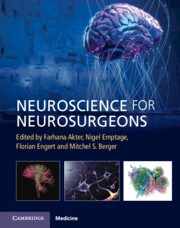Book contents
- Neuroscience for Neurosurgeons
- Neuroscience for Neurosurgeons
- Copyright page
- Contents
- Contributors
- Section 1 Basic and Computational Neuroscience
- Chapter 1 Neuroanatomy
- Chapter 2 Cerebral Autoregulation
- Chapter 3 Neuroimmune Interactions
- Chapter 4 Anatomy and Physiology of the Neuron
- Chapter 5 Synaptic Transmission
- Chapter 6 Sensory Pathways
- Chapter 7 Somatosensory and Somatic Motor Systems
- Chapter 8 Neuron Models
- Chapter 9 An Introduction to Artificial Intelligence and Machine Learning
- Chapter 10 Artificial Intelligence in Neuroscience
- Chapter 11 Probability and Statistics
- Section 2 Clinical Neurosurgical Diseases
- Index
- References
Chapter 6 - Sensory Pathways
from Section 1 - Basic and Computational Neuroscience
Published online by Cambridge University Press: 04 January 2024
- Neuroscience for Neurosurgeons
- Neuroscience for Neurosurgeons
- Copyright page
- Contents
- Contributors
- Section 1 Basic and Computational Neuroscience
- Chapter 1 Neuroanatomy
- Chapter 2 Cerebral Autoregulation
- Chapter 3 Neuroimmune Interactions
- Chapter 4 Anatomy and Physiology of the Neuron
- Chapter 5 Synaptic Transmission
- Chapter 6 Sensory Pathways
- Chapter 7 Somatosensory and Somatic Motor Systems
- Chapter 8 Neuron Models
- Chapter 9 An Introduction to Artificial Intelligence and Machine Learning
- Chapter 10 Artificial Intelligence in Neuroscience
- Chapter 11 Probability and Statistics
- Section 2 Clinical Neurosurgical Diseases
- Index
- References
Summary
Our visual system is critical to accessing information and communicating with others. The visual pathway begins with a photon of light traveling through the pupil of the eye to the retinal photoreceptors to induce a signaling cascade responsible for transmitting electrical information to the brain.
- Type
- Chapter
- Information
- Neuroscience for Neurosurgeons , pp. 99 - 120Publisher: Cambridge University PressPrint publication year: 2024



